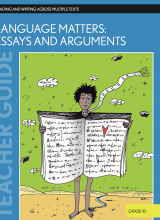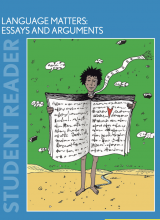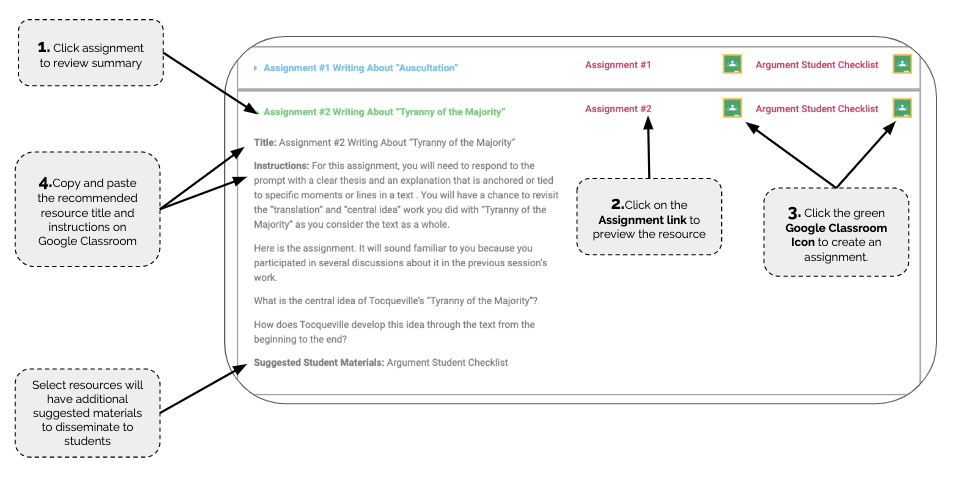Language Matters: Essays and Arguments - Grade 10
In this unit, students will read and write carefully crafted essays linked by the theme of “bilingualism.”
The work in this unit is divided into four parts. In Parts 1 and 2, students will study two texts in which the authors make arguments about the issue of “bilingualism.” The first text, an essay by the poet Martín Espada, takes a different position than the second, a short selection from Richard Rodriguez’s book Hunger of Memory. During the work with these two texts, students will take time to study each author’s arguments and then to locate each author’s position relative to the other.


Table of Contents
Writing Tasks
Title: Summarizing Espada: Crafting a Retelling
Teacher Manual Instructions:
Session 2
Review the assignment with the class and answer any questions students have about it. Retellings—which are not quite the same as summaries—typically go into a bit more detail than a summary, but may not dig deeply into the “big ideas” of the text.
Title: Studying Espada’s Arguments
Teacher Manual Instructions:
Session 3
Explain to students that the work of the previous sessions has prepared them to take on this next assignment, a task dedicated to thinking about Espada’s arguments about “bilingualism” in his essay.
Suggested Student Materials: Informational_Explanatory Checklist
Title: Hunger of Memory: Public and Private Language
Teacher Manual Instructions:
Session 8
Suggested Student Materials: Informational_Explanatory Checklist
Title: Studying Rodriguez’s Arguments
Teacher Manual Instructions:
Session 10
Groups should use the work period to begin work on the first question: “What, according to Rodriguez, is ‘bilingualism’?” Tell students that they should work on this question before moving on to the second part of the assignment. Remind students that they should make notes as they negotiate answers and understandings of the question.
Suggest to the students that they jot the question—“What, according to Rodriguez, is “bilingualism?”—at the top of a notebook page. By making notes on this page, they’ll have a record of their thinking that they can add to and revise during the whole class discussion ahead.
Title: Espada and Rodriguez on Bilingualism
Teacher Manual Instructions:
Session 12
Review the assignment with the class and answer any questions students have about the task.
Suggested Student Materials: Informational_Explanatory Checklist
Title: Examining Lee’s Position
Teacher Manual Instructions:
Session 18
Give students time to independently reread Lee’s essay and to mark moments or lines in the essay that seem important given the task at hand.
Afterwards, skim through Lee’s essay again with the class, using a display copy of the essay to guide the work. As you skim, ask students to point out and explain places they marked during the rereading. Add these marks to the display copy and ask students to help you make a note next to each that annotates or summarizes what is going on in that part.
Next, collaborate with the class to revisit the positions that Espada and Rodriguez stake out in their texts. To do this, revisit display copies of the texts and the comparison chart created during Session 13.
Title: Writing About Multiple Texts The Final Essay
Teacher Manual Instructions:
Session 20
Take time to review “The Final Essay” assignment with the class and answer any questions students may have.
Suggested Student Materials: Interpretive_Argument Checklist
Charts for Discussion
Title: “The New Bathroom Policy”: Whole-Class Retelling
Teacher Manual Instructions:
Session 2
Invite the class to work with you to generate a whole-class retelling of “The New Bathroom Policy at English High School.” This retelling should reflect the class’s sense of what is most significant in the text. (For this reason, each class’s retelling will inevitably be somewhat different.)
Capture the results of this process on a chart titled something like “’The New Bathroom Policy’: Whole-Class Retelling.” Ask students to copy the class’s ver- sion of the retelling in their notebooks as well.
- This whole-group retelling is intended as a common reference map to the text for the work ahead and, as such, should include page and line numbers of any moments or lines cited.
- Collect students’ retellings if you wish to score or provide feedback.
Title: Bilingualism: Comparing Espada and Rodriguez
Teacher Manual Instructions:
Session 13
Ask the class to help you create and begin to fill in a simple two-column chart like the one shown nearby. Title the chart something like “Bilingualism: Comparing Espada and Rodriguez.”
An alternate way to construct this chart is to add a third column in the middle so that topics or issues can be highlighted and listed. This might help students who are struggling to imagine points of contrast to more easily see and say how and why the two writers disagree.
Students should create a copy of this chart in their notebooks as well.
To begin this work, skim the display copy of Espada’s essay that contains the marks and annotations for the retrospective task (from Session 12). As you skim the text, ask students to help you formulate statements or topics to enter onto the chart. In addition, be sure to excerpt or cite specific moments or lines in the texts to illustrate any entries students recommend.
Use the task question to frame the discussion: Imagine that Espada and Rodriguez are on different sides of a debate about bilingualism and that they have different positions. What would Espada’s position be?
Next, repeat the same process using the annotated display copy of Rodriguez’s selection (from Session 12), framing the discussion with the same question.
Point out that the items entered on the chart can form the heart of a paper. In other words, the chart is a graphic representation of the writers’ positions.
When it appears that students understand how to proceed with the work, move them into small groups to continue building the chart (in their notebooks).
Title: Bilingualism: Comparing Lee
Teacher Manual Instructions:
Session 18
Work with the class to create a companion comparison chart for Lee’s essay, complete with lines excerpted from the essay to illustrate the statements on the chart. Title the chart something like “Bilingualism: Comparing Lee.”
Checks for Understanding
Title: “The New Bathroom Policy at English High School” Important and Confusing Lines
Teacher Manual Instructions:
Session 1
Reconvene the class and invite students to share the moments in the essay they marked. Capture these moments or lines on a chart. To do this you might create a two-column chart or create two separate charts—one for important lines and the other for confusing lines, where you can also write students’ questions about the text in order to return to them as appropriate during the following sessions.
Title: “Hunger of Memory” Important and Confusing Lines
Teacher Manual Instructions:
Session 6
Reconvene the class and invite students to share the moments in the essay they marked. Capture these moments or lines on a chart. To do this you might create a two-column chart or create two separate charts—one for important lines and the other for confusing lines, where you can also write students’ questions about the text in order to return to them as appropriate during the following sessions.
Title: Hunger of Memory: Public and Private Language
Teacher Manual Instructions:
Session 8
Check for understanding: Throughout the discussion, work to capture and distill the students’ thinking about Rodriguez’s notions of “private” and “public” language on a chart titled “Hunger of Memory: Public and Private Language.” This chart will be an important resource for the upcoming retrospective task.
Title: Lee’s Arguments About Bilingualism
Teacher Manual Instructions:
Session 17
In addition to facilitating this conversation, work hard to capture and distill the major ideas that students are developing on a class chart titled something like “Lee’s Arguments About Bilingualism.”
Title: Lee’s Position on Bilingualism
Teacher Manual Instructions:
Session 19
In addition to facilitating this conversation, work hard to capture and distill the major ideas that students are developing on a class chart titled something like “Lee’s Position on Bilingualism.”
Independent Reading
Title: Book Interview
Instructions:
Display a copy of the “Book Interview” sheet for the class to see and distribute copies to students.
Using one of the books from the classroom library, model for students how to interview a book and how to fill out the sheet. Answer any questions students have about the form and its terminology.
Give students time to interview three books and to enter their findings on the “Book Interview” sheet.
Title: Book Pass
Instructions:
Organize students’ desks into a circle (or, if this is not possible, determine a very clear path for books to pass through the group).
Explain the purpose of a book pass:
A book pass is another way to expose students to the texts available in the classroom library. A book pass requires students to use their book interviewing skills. A book pass is a chance for students to find titles to add to their “Books I’d Like to Read” list.
Display a copy of the “Book Pass” for the class to see and pass out copies to students.
Demonstrate for the class how a person goes about making an entry on the form. Since students will need to write quickly, show how an author can be listed just by last name and first initial, and demonstrate how a student can abbreviate a long title if necessary. What matters is that they have enough information to track down the book again later if they need to.
Give each student one book (or magazine). Tell them it doesn’t matter which text they start with, because they will see all—or at least many of—the books. (Be sure you have one title for each student in the circle.)
Choose a direction for passing.
After students receive a book, they should immediately record the author’s name (if the text is a book) and title on the “Book Pass” form.
Give students one minute to interview each book following the procedure established in the previous session.
At the end of one minute, call “pass.” At this time, students should make an entry in the comments column and pass the book to the next student.
Continue the book pass until each student has interviewed all the books.
Title: Book Recommendation
Instructions:
Distribute copies of the “Book Recommendation” form to students and give them time to craft or begin crafting their first review. Students can choose to write about a book they’ve completed recently or one they remember well from past reading.
Title: Goals for My Reading Life
Instructions:
Display a copy of “Goals for My Reading Life” for the class to see and distribute copies to students.
Use this time to review how to fill out the goals sheet. Be sure to show students how they can use the charts to generate ideas for answers to the “Goals” questions.
Take a moment to stress the value and function of the “Books I’d Like to Read” list. Point out that this list is a tool that serves the same function as a bedside table for some readers: It is a place to store up titles or books that are “next in line.” Remind the class that readers constantly have their eyes open for “next” texts. A “Books I’d Like to Read List” is a way to prevent aimless and unproductive castings around for new reading materials. It’s a planning tool.
Explain that at the beginning of each marking period, each student will fill out a new goals sheet; at at the end of each marking period, students will take a few minutes to review their goals statements and reflect on their efforts to meet them.
Answer any questions students have about the “Goals for My Reading Life” forms.
Give students time to complete the form and set a deadline for submission. You may decide to photocopy these to keep a set for yourself. Return the forms to students during the next session and have them attach the form to a page in their notebook or save it for their student portfolio (see Creating a Student Portfolio).
Title: Reading Log
Teacher Manual Instructions:
Show students how to set up a “Reading Log” in their notebook. They should be sure to enter it in their table of contents. You may decide to distribute sticky notes so that students can flag this page. Use the model on the next page to guide your efforts.
Notice the column titled “Date Completed/# of Pages Read.” This column is a place for students to record, and receive credit for, the reading of texts that did not require a “cover-to-cover” experience. Be sure to point out that reading sections of several texts for specific purposes is not the same as skipping aimlessly from book to book to book. The former often indicates purposefulness and interest; the latter can indicate confusion or disengagement.
After students have set up the reading log—including proper headings, creating the grid, etc.—demonstrate how to make an entry.
Answer any questions students have about the log.
Remind students that the reading log is a tool to be used in conjunction with the “Goals” sheets. Students track their reading in the log and then use the log to evaluate their progress toward their goals.
If you plan to use student portfolios this year, consider introducing them at this time using some version of the information in the section that follows. Review Creating a Student Portfolio in advance to be sure you have thought through some of the important questions for portfolio work.
Unit Resources
Title: Studying Rodriguez: Public and Private Language
Title: The First Retrospective Task: Espada and Rodriguez on Bilingualism
Title: The Second Retrospective Task: Examining Lee’s Position
Title: Writing About Multiple Texts: The Final Essay
Title: Grades 9 and 10 – Interpretive_Argument Rubric
Title: Grades 9 and 10 – Informational_Explanatory Rubric
Title: Scaffolds and Modifications: Descriptions and Use
